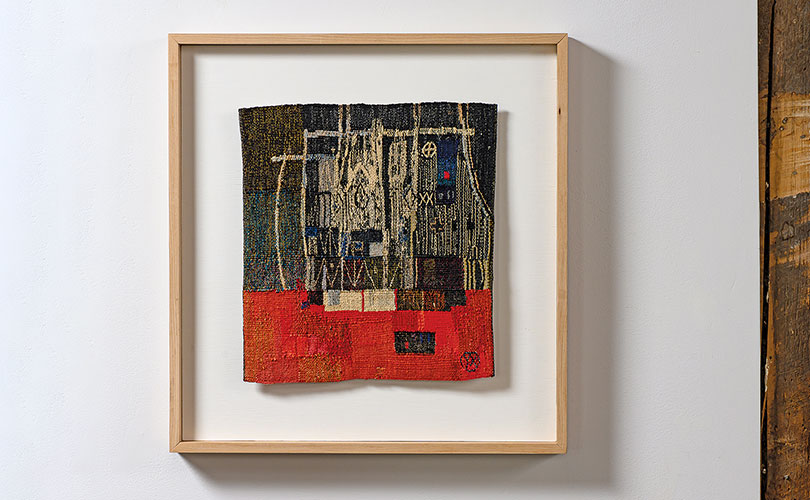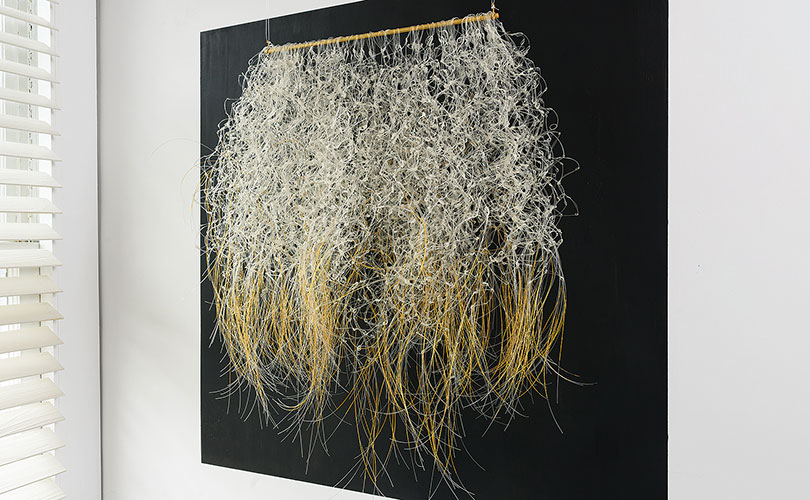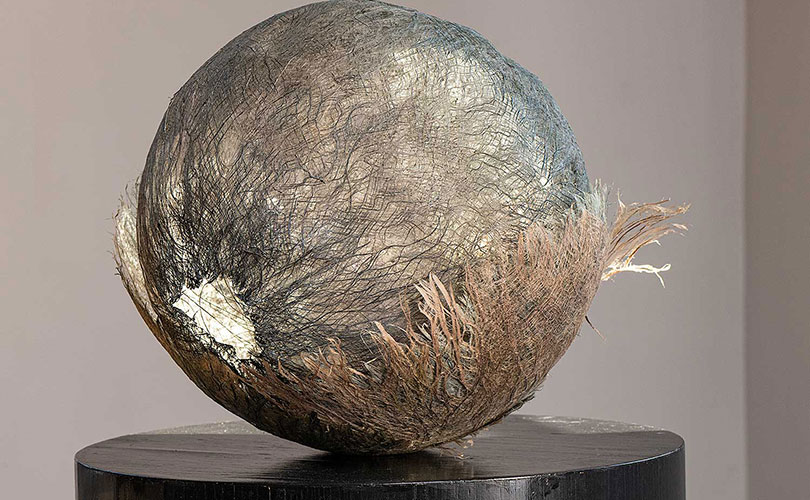Discourse:: art across generations and continents opens in just three days at browngrotta arts, Wilton, Connecticut (May 4 – 12). The exhibition includes works by five artists whose work we have not shown before:

Neda Al-Hilali was born in Czechoslovakia in 1938 and lived in Baghdad before moving to Southern California in 1961. She trained as an artist in Europe, and extensively at the University of California Los Angeles, including with Bernard Kestler. In the 1960s, she created flat weavings and knotted hangings, called “Rope Art,” by Life magazine December 1, 1972. Those were followed by room-sized installations, cascades of paper, and works of aluminum modules and others of pieced paper. Her career, the Los Angeles Times wrote, “moved into painting and sculpture with intelligent disregard for confining labels.” Al-Halili’s work will be included in the upcoming exhibition at the Renwick Gallery, Smithsonian American Art Museum, Subversive, Skilled, Sublime: Fiber Art by Women in Washington, D.C. in May.

Finnish textile artist Margareta Ahlstedt-Willandt (1888 -1967) was a founder of an artistic weaving company. Ahlstedt-Willandt founded an Agency and Weavery for the Decorative Arts in 1924 which employed a dozen people. Its products were sold not only in Finland, but also abroad. Ahlstedt-Willandt was awarded prizes in many international exhibitions of applied art and design. She received several awards including a silver medal at the art and industry exhibitions in Barcelona in 1929 and in Milan in 1933 and a gold medal at the Paris World Exhibition in 1937. In 1930, she had a solo exhibition at the Museum of Applied Art Arts (now the Design Museum) in Helsinki. Her memorial exhibition was held at the Design Museum in 1988.

Awarding-winning artist, Yvonne Bobrowicz (1928 – 2022) was known for her cascading, light-transmitting sculptures made of synthetic monofilament. Bobrowicz was concerned with interconnections — interconnectedness and continuum. The artist told the Senior Artists Initiative in Philadelphia in 2003, “My work has been combining natural materials with synthetics, relating opposites, randomness and order — dark, light, reflective, opaque, and light absorbent, incorporating gold leaf, reflecting sculptures of monofilament, reflective and alchemically symbolic — unifying them in a variety of densities, scale, and configurations.” Her interest in interconnections is an ideal artist for inclusion in Discourse. Bobrowicz studied with Marianne Strengell at the Cranbook Academy of Art and with Anni Albers at the Philadelphia Museum and School of Industrial Art, now University of the Arts. In the 1980s, she collaborated with renowned architect Louis Kahn. She taught weaving and textiles at Drexel University for more than 30 years. She was the recipient of a Pew Fellowship and a grant from the Leeway Foundation.

Mika Watanabe is a contemporary multi-media artist and art educator. Watanabe creates sculptural objects using natural paper fiber and body parts of animals and humans (nails, snake shed, hog guts, etc). She has created installations using various unique objects. Her work has been exhibited by local, national, and international contemporary arts and crafts galleries and museums, including in the 2005 traveling exhibition Intertwined: Contemporary Baskets from the Sara and David Lieberman Collection. Watanabe holds a Masters of Fine Arts from the California College of Art in Oakland and a Bachelor’s of Arts in Fine Arts, Crafts, Industrial Design Arts from Musashino Arts University in Tokyo Japan.

Japanese jewelry designer, artist, author, and educator, Hiroko Sato-Pijanowski, was born in Tokyo, Japan in 1942. She received an MFA in 1966 from the Cranbrook Academy of Art, in Michigan, began teaching Metalsmithing in 1986 at The University of Michigan, and continued until 2001 when she retired as Professor Emeritus. Sato-Pijanowski is credited with introducing Japanese materials and techniques to American metal working. In the 80s, Sato-Pijanowski (sometimes with her husband, Eugene Pijanowski), made a series of oversized, wearable works out of paper cord and foils using a technique called mizuhiki. “In making my paper cord jewelry,” Sato-Pijanoowski wrote in 2017, I realized that form can have meaning beyond mere abstract beauty. The contrasts between this organic material and its artificial metallic color, and between the traditional applications of paper cord and these abstract designs, comment on the evolution of man’s position in the universe. We are part of the natural world and of a historic and cultural world of our own making.”
Join us for Discourse: art across generations and continents from May 4 to May 12th. Reserve a time at POSH.
